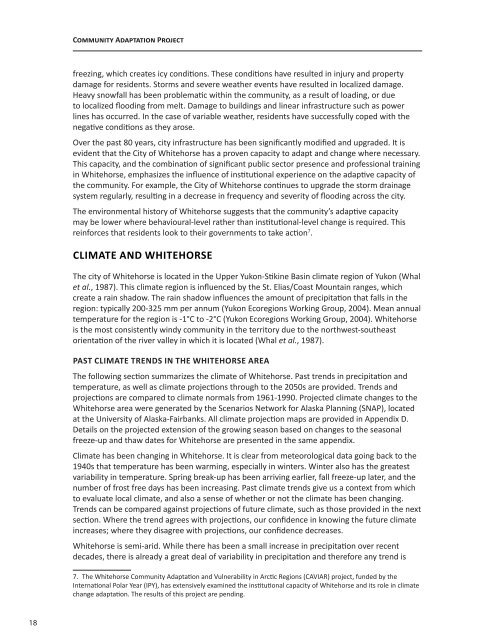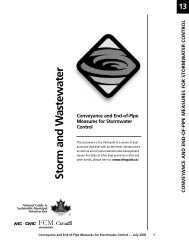Whitehorse Climate Change Adaptation Plan - Yukon College
Whitehorse Climate Change Adaptation Plan - Yukon College
Whitehorse Climate Change Adaptation Plan - Yukon College
Create successful ePaper yourself
Turn your PDF publications into a flip-book with our unique Google optimized e-Paper software.
18<br />
Community <strong>Adaptation</strong> Project<br />
freezing, which creates icy conditions. These conditions have resulted in injury and property<br />
damage for residents. Storms and severe weather events have resulted in localized damage.<br />
Heavy snowfall has been problematic within the community, as a result of loading, or due<br />
to localized flooding from melt. Damage to buildings and linear infrastructure such as power<br />
lines has occurred. In the case of variable weather, residents have successfully coped with the<br />
negative conditions as they arose.<br />
Over the past 80 years, city infrastructure has been significantly modified and upgraded. It is<br />
evident that the City of <strong>Whitehorse</strong> has a proven capacity to adapt and change where necessary.<br />
This capacity, and the combination of significant public sector presence and professional training<br />
in <strong>Whitehorse</strong>, emphasizes the influence of institutional experience on the adaptive capacity of<br />
the community. For example, the City of <strong>Whitehorse</strong> continues to upgrade the storm drainage<br />
system regularly, resulting in a decrease in frequency and severity of flooding across the city.<br />
The environmental history of <strong>Whitehorse</strong> suggests that the community’s adaptive capacity<br />
may be lower where behavioural-level rather than institutional-level change is required. This<br />
reinforces that residents look to their governments to take action7 .<br />
CLIMATE AND WHITEHORSE<br />
The city of <strong>Whitehorse</strong> is located in the Upper <strong>Yukon</strong>-Stikine Basin climate region of <strong>Yukon</strong> (Whal<br />
et al., 1987). This climate region is influenced by the St. Elias/Coast Mountain ranges, which<br />
create a rain shadow. The rain shadow influences the amount of precipitation that falls in the<br />
region: typically 200-325 mm per annum (<strong>Yukon</strong> Ecoregions Working Group, 2004). Mean annual<br />
temperature for the region is -1°C to -2°C (<strong>Yukon</strong> Ecoregions Working Group, 2004). <strong>Whitehorse</strong><br />
is the most consistently windy community in the territory due to the northwest-southeast<br />
orientation of the river valley in which it is located (Whal et al., 1987).<br />
PAST CLIMATE TRENDS IN THE WHITEHORSE AREA<br />
The following section summarizes the climate of <strong>Whitehorse</strong>. Past trends in precipitation and<br />
temperature, as well as climate projections through to the 2050s are provided. Trends and<br />
projections are compared to climate normals from 1961-1990. Projected climate changes to the<br />
<strong>Whitehorse</strong> area were generated by the Scenarios Network for Alaska <strong>Plan</strong>ning (SNAP), located<br />
at the University of Alaska-Fairbanks. All climate projection maps are provided in Appendix D.<br />
Details on the projected extension of the growing season based on changes to the seasonal<br />
freeze-up and thaw dates for <strong>Whitehorse</strong> are presented in the same appendix.<br />
<strong>Climate</strong> has been changing in <strong>Whitehorse</strong>. It is clear from meteorological data going back to the<br />
1940s that temperature has been warming, especially in winters. Winter also has the greatest<br />
variability in temperature. Spring break-up has been arriving earlier, fall freeze-up later, and the<br />
number of frost free days has been increasing. Past climate trends give us a context from which<br />
to evaluate local climate, and also a sense of whether or not the climate has been changing.<br />
Trends can be compared against projections of future climate, such as those provided in the next<br />
section. Where the trend agrees with projections, our confidence in knowing the future climate<br />
increases; where they disagree with projections, our confidence decreases.<br />
<strong>Whitehorse</strong> is semi-arid. While there has been a small increase in precipitation over recent<br />
decades, there is already a great deal of variability in precipitation and therefore any trend is<br />
7. The <strong>Whitehorse</strong> Community <strong>Adaptation</strong> and Vulnerability in Arctic Regions (CAVIAR) project, funded by the<br />
International Polar Year (IPY), has extensively examined the institutional capacity of <strong>Whitehorse</strong> and its role in climate<br />
change adaptation. The results of this project are pending.

















